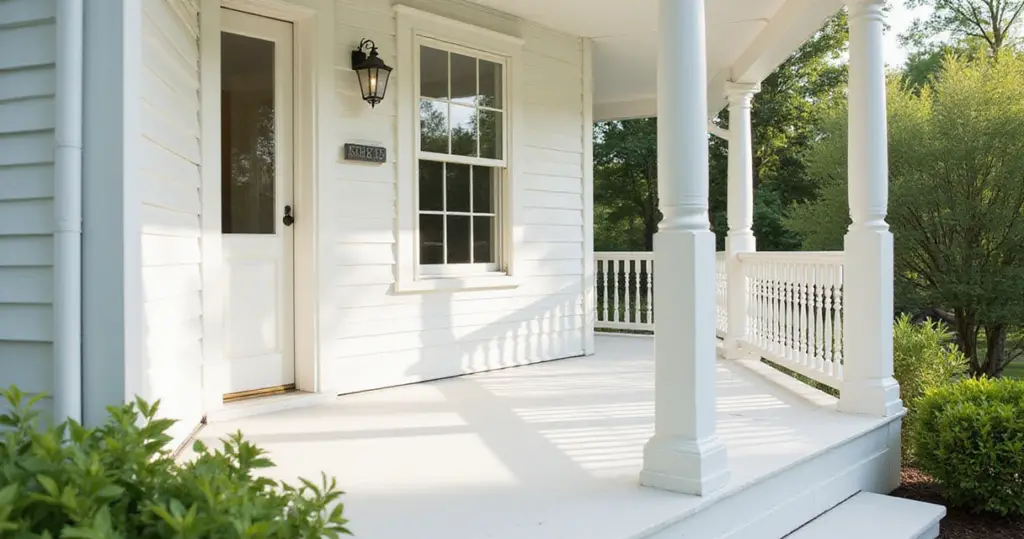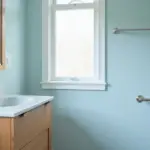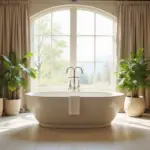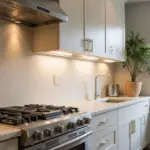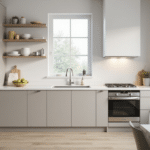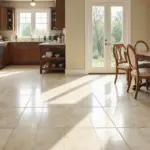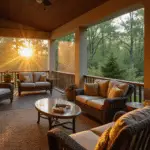Your porch exists at the intersection of digital and physical life—the threshold where the outside world meets your inner sanctuary. In our hyper-connected age, a thoughtfully painted porch creates that crucial decompression zone between the digital demands of modern life and the mindful serenity we crave at home.
I’ve curated these 20 porch paint ideas specifically for those seeking balance between contemporary aesthetics and traditional calm. Each option considers both visual impact and the psychological transition from external chaos to internal peace—something increasingly valuable in our notification-filled lives.
1. Classic White Elegance: The Digital Detox Canvas
White porches offer more than just timeless charm—they provide a visual reset button for tech-saturated minds. The absence of color creates a mental clearing, allowing your brain to decompress from screens and digital stimulation. This neutrality serves as the perfect transitional space between the information-heavy outside world and your mindful interior.
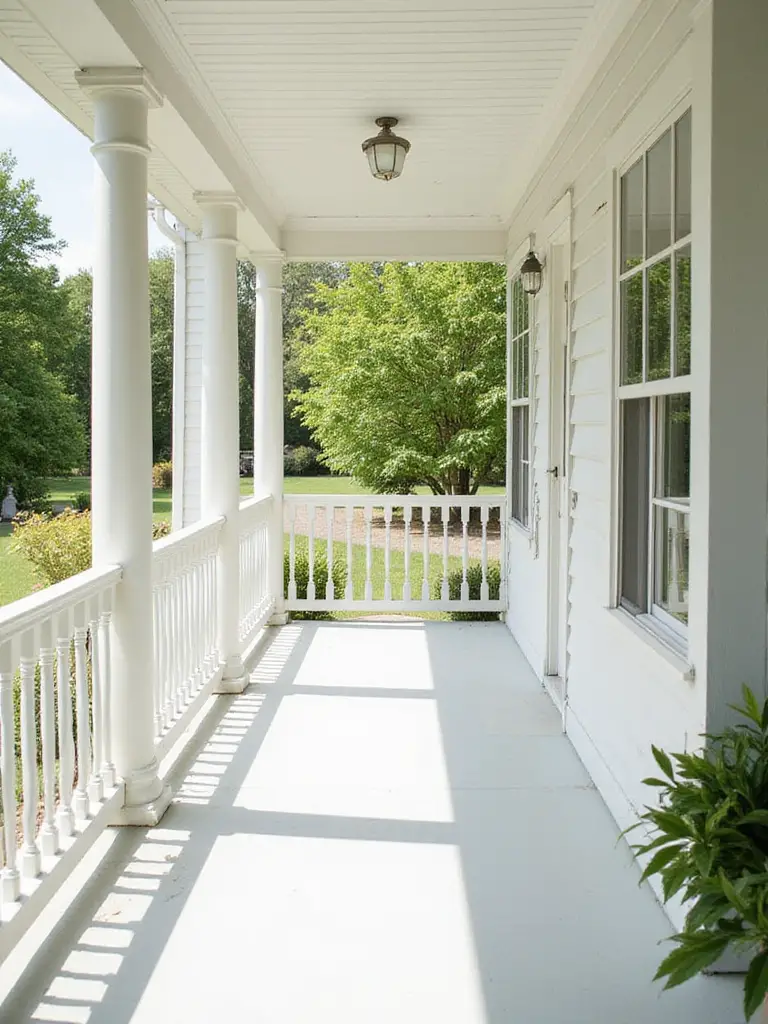
When selecting your white, consider how it will function in different light conditions throughout the day. Cool whites with blue undertones create a crisp, contemporary feel that pairs beautifully with minimalist furniture and clean lines. Warmer whites with cream undertones offer a softer landing space, especially welcoming when illuminated by evening porch lights as you return from a day of digital demands.
“White space in design allows the eye to rest. A white porch creates this same respite for the mind—a blank canvas that doesn’t compete for your already divided attention.”
The simplicity of white creates space for intentional tech integration later—whether through subtle lighting systems or weather-resistant speakers that won’t visually compete with your clean palette.
2. Modern Gray Sophistication: The Digital-Friendly Neutral
Gray has emerged as the quintessential modern neutral, perfectly bridging traditional architecture with contemporary digital lifestyles. Unlike the stark reset of white, gray provides subtle visual texture that masks the inevitable digital debris of modern life—from the occasional charging cable to smart lighting components.
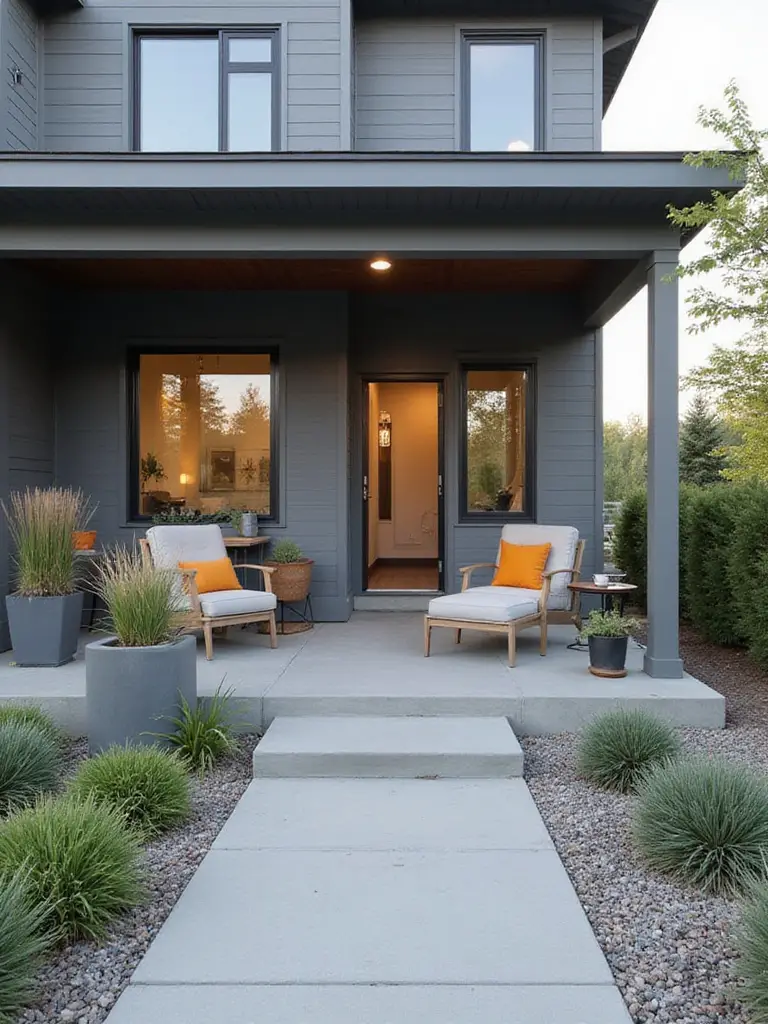
The key to a successful gray porch lies in selecting the right depth and undertone. Light grays with warm undertones create an inviting transition space that feels both current and timeless. Medium to dark grays with blue undertones offer a more dramatic statement that pairs beautifully with the metallic finishes of modern tech accessories and smart home features. Consider how your chosen gray will interact with both natural daylight and the artificial glow of devices and smart lighting in evening hours.
- Pair light greige with natural wood elements for a balance of warm and cool
- Use charcoal gray for a dramatic backdrop that makes tech accessories disappear
- Consider blue-gray tones that echo the color of digital screens for subtle cohesion
The unobtrusive nature of gray creates the perfect backdrop for integrating technology without visual disruption, allowing your smart porch features to blend seamlessly into the background.
3. Coastal Blue Breeze: Digital Calm Through Color Psychology
Blue tones have a scientifically proven calming effect on the nervous system—exactly what’s needed in our notification-saturated lives. A coastal blue porch creates a transitional space that signals to your brain it’s time to downshift from high-alert digital mode to a more contemplative state of mind.
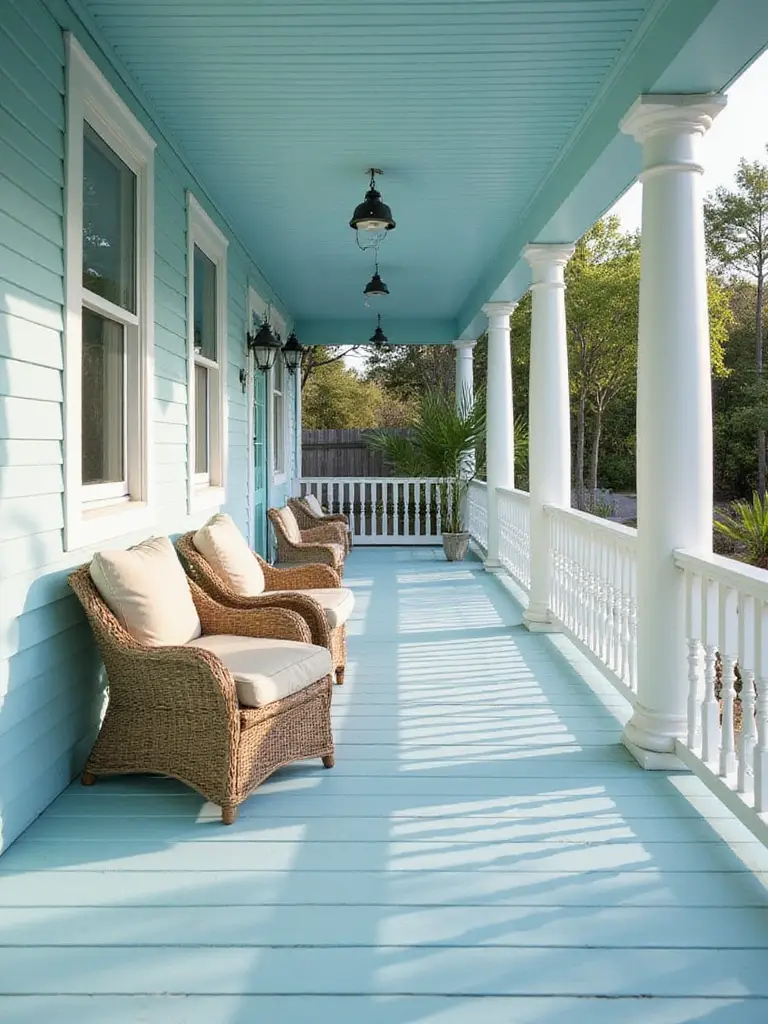
The spectrum of coastal blues offers different psychological benefits. Lighter sky blues visually expand the space, creating an airy feeling that counteracts the claustrophobia of too much screen time. Deeper navy tones provide grounding and stability—a visual anchor for minds scattered by digital distractions. The key is selecting a blue that resonates with your personal response to color while complementing your home’s architecture.
- Sky blue: Creates mental expansion and airiness
- Navy: Offers psychological grounding and focus
- Aqua: Bridges the gap between stimulation and relaxation
As you transition from busy digital environments to your home sanctuary, these blue tones create a neurological bridge, helping your mind release work stress before entering your personal space.
4. Nature-Inspired Green Serenity: The Biophilic Connection
Green porch paint creates a crucial biophilic link between digital life and natural rhythms. As our lives become increasingly screen-dominated, this connection to nature becomes not just aesthetically pleasing but psychologically necessary. A green porch serves as the perfect transitional buffer, helping tech-saturated minds reconnect with natural elements.
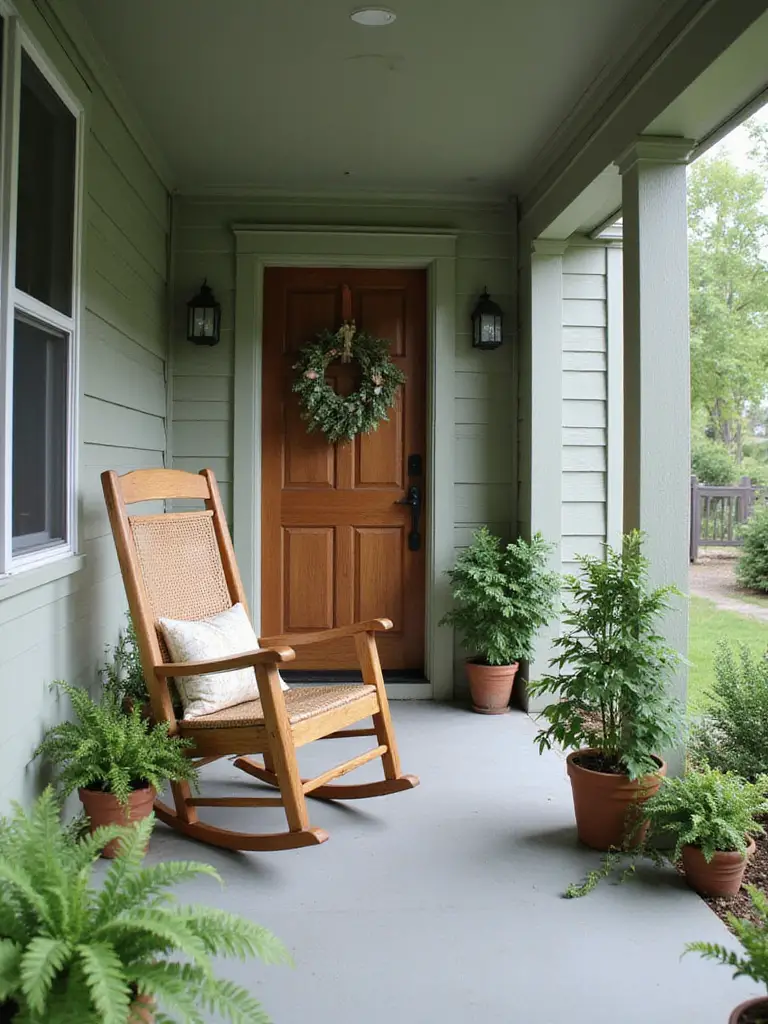
When selecting green for your porch, consider both its visual impact and its psychological function. Sage greens with gray undertones create a sophisticated, muted backdrop that allows both technology and natural elements to coexist without visual competition. Forest greens provide a deeper immersion into nature, creating a more definitive boundary between digital and natural worlds. Mint greens offer a contemporary take that bridges traditional and modern sensibilities—perfect for those who appreciate both heritage design and current technology.
“The human eye can distinguish more shades of green than any other color—a evolutionary adaptation that connected us to our natural environment. A green porch reactivates this primal connection.”
This natural color palette creates an ideal environment for integrating both technology and traditional elements, allowing smart features to blend seamlessly with more timeless porch components.
5. Farmhouse Red Warmth: Traditional Comfort Meets Modern Function
Red porch paint offers a fascinating psychological counterpoint to the cool blues of digital screens. This warm, grounding color creates a visual and emotional transition from the cool, information-heavy digital world to the warm, connection-focused home environment. The traditional associations of red with hearth and home make it particularly effective for creating a psychological boundary between work and personal life.
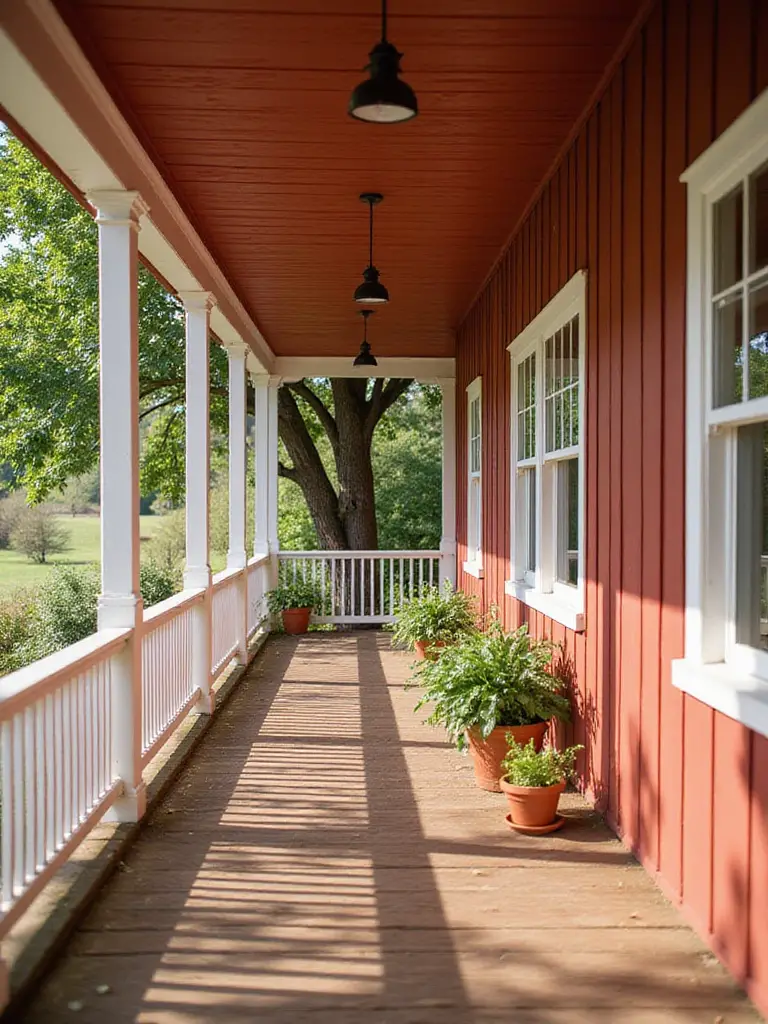
When selecting red for your porch, avoid overly bright or saturated options that might create visual tension. Instead, opt for barn reds, brick reds, or terracotta tones that have been slightly muted or aged. These subdued reds provide warmth without overstimulation—crucial for minds already processing significant digital input. Consider how your chosen red will appear not just in daylight but also under evening porch lighting, when its warmth becomes even more pronounced and welcoming.
- Barn red: Traditional and grounding
- Brick red: Urban sophistication with warmth
- Terracotta: Earthy transition with natural elements
The warmth of red creates a perfect counterbalance to the cool glow of devices, allowing both traditional comfort and modern function to coexist in your transitional porch space.
6. Bold Black Statement: Digital Minimalism Materialized
Black porch paint represents the ultimate in digital minimalism—a bold visual statement that creates clear boundaries between spaces and functions. In our era of constant visual stimulation, a black porch creates a definitive transition point, signaling to your brain that you’re crossing a threshold from public to private, from external demands to internal peace.
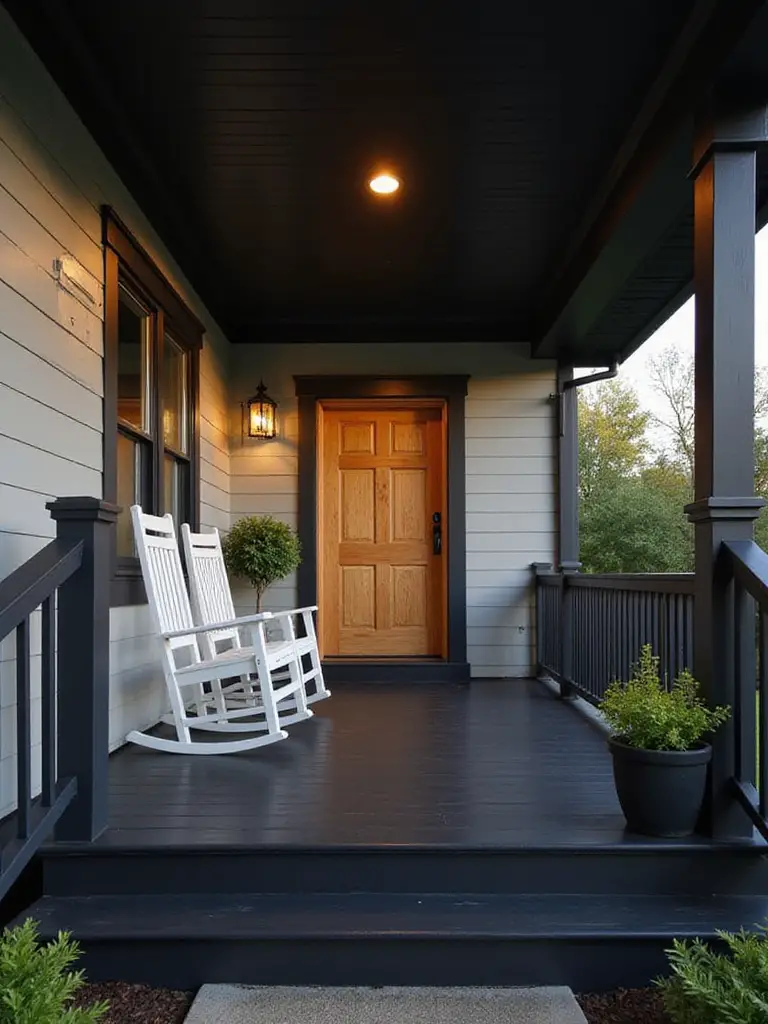
The sophistication of black works particularly well when contrasted with clean architectural lines and thoughtfully integrated technology. Consider how black surfaces interact with both natural and artificial light—during the day, black creates dramatic shadows and highlights architectural details; at night, it provides the perfect backdrop for subtle lighting systems and glowing screens without competing visually. For optimal results, pair black with crisp white trim to prevent the space from feeling too heavy or enclosed.
“Black isn’t just absence—it’s presence. A black porch doesn’t just absorb light; it absorbs distraction, creating mental space for what matters.”
This dramatic color choice creates a powerful reset button between the outside world and your inner sanctuary, perfect for those seeking definitive boundaries in an increasingly boundary-less digital world.
7. Two-Tone Porch Perfection: Delineating Digital and Analog Zones
Two-tone porch paint offers a sophisticated solution for creating distinct functional zones in your transitional space. This approach allows you to visually separate areas dedicated to different activities—perhaps a more tech-friendly conversation zone versus a more unplugged reading nook—without installing physical barriers.
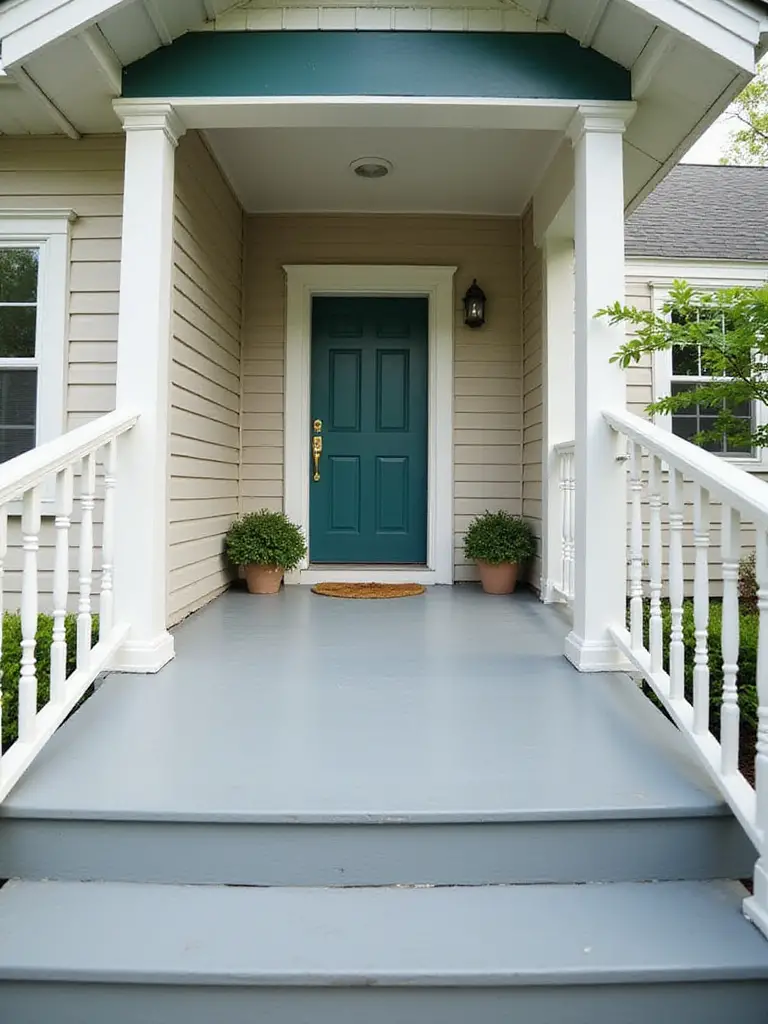
The most effective two-tone combinations maintain harmony while creating clear visual distinction. Consider pairing a deeper, more saturated color for floors (which grounds the space and hides inevitable digital debris) with lighter tones for vertical surfaces that reflect light and create openness. The contrast between these elements creates visual interest while serving the practical purpose of defining different functional areas within the same space.
- Floor/ceiling contrast: Creates vertical expansion
- Railing/floor contrast: Defines boundaries while maintaining flow
- Step contrast: Guides movement and transitions
The interplay between two distinct colors creates natural organization without rigidity—perfect for a space that needs to accommodate both traditional relaxation and modern connectivity.
8. Stenciled Floor Artistry: Mindful Patterns in a Digital World
Stenciled floor patterns offer more than mere decoration—they create intentional focal points that draw the eye away from screens and back to physical space. In a world of digital distraction, these tangible patterns reconnect us with traditional craftsmanship and mindful design, creating a mental bridge between digital efficiency and analog satisfaction.
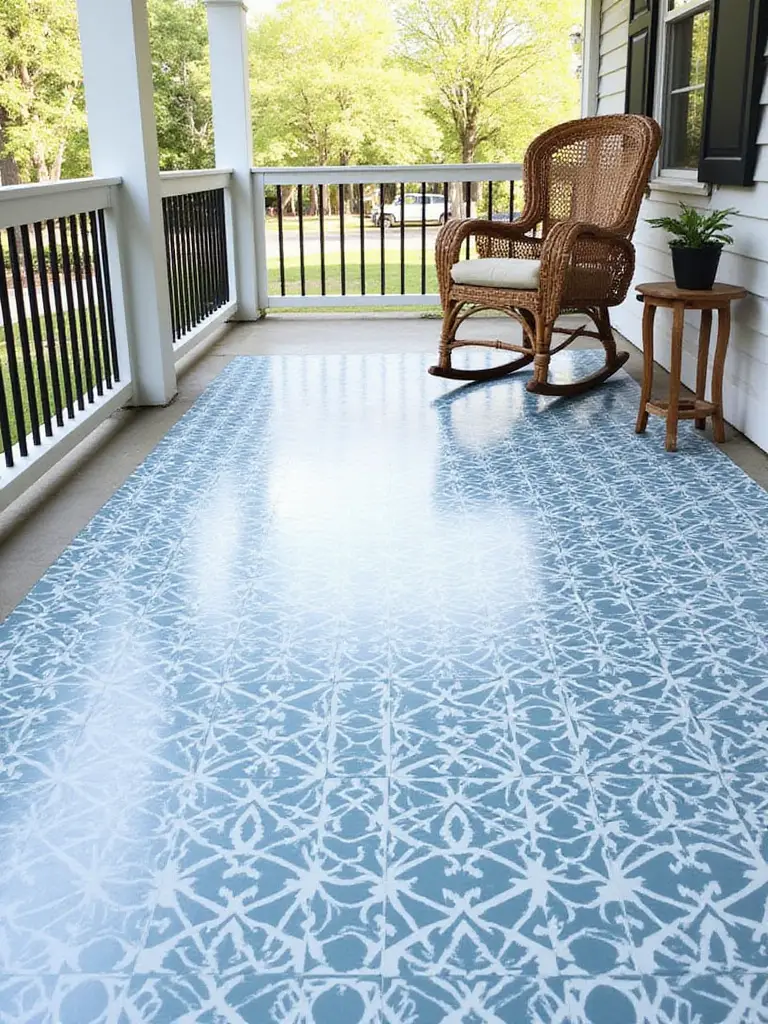
The key to successful stenciling lies in balancing complexity with clarity. Geometric patterns provide structure and order—a welcome counterpoint to the chaotic flow of digital information. Organic patterns like botanical motifs reconnect us with natural rhythms that technology often disrupts. When selecting a stencil pattern, consider not just its visual appeal but its psychological impact—how it guides movement through the space and where it draws the eye.
- Geometric patterns: Create order and structure
- Botanical patterns: Reconnect with natural rhythms
- Traditional patterns: Link to cultural heritage and continuity
This intersection of traditional technique and contemporary design creates a perfect transitional element between the digital and physical aspects of modern life.
9. Painted Rug Illusion: Physical Anchoring in a Virtual World
The painted rug illusion serves as a powerful grounding technique in our increasingly virtual existence. By creating the visual weight and definition of a textile without its physical presence, this porch paint idea helps define gathering spaces while maintaining the clean, uncluttered aesthetic that complements our digital lives.
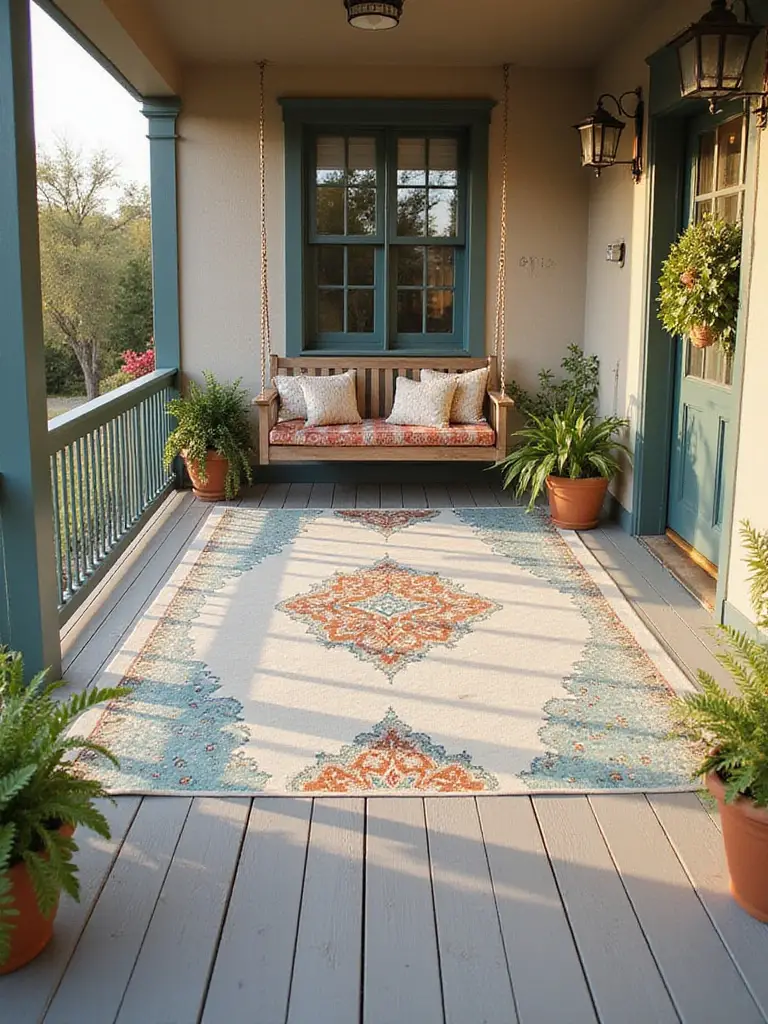
When designing your painted rug, consider both traditional rug patterns and more contemporary geometric designs that might better complement modern architecture and technology. The defined boundaries of the painted rug create an implicit invitation to gather, helping to facilitate the face-to-face connections that balance our digital interactions. For maximum impact, ensure the “rug” dimensions properly fit your furniture arrangement, creating a cohesive conversation area that encourages engagement.
“The painted rug creates a psychological anchor in space—a visual cue that this area is meant for presence, not just passing through.”
This blend of traditional spatial definition and modern execution perfectly bridges the gap between heritage design principles and contemporary living needs.
10. Timeless Checkerboard Chic: Ordered Pattern for Digital Minds
The checkerboard pattern speaks directly to our digital sensibilities—its binary nature echoes the underlying structure of our technological world while its historic pedigree connects us to design traditions that long predate digital life. This balance makes it particularly effective for transitional spaces like porches.
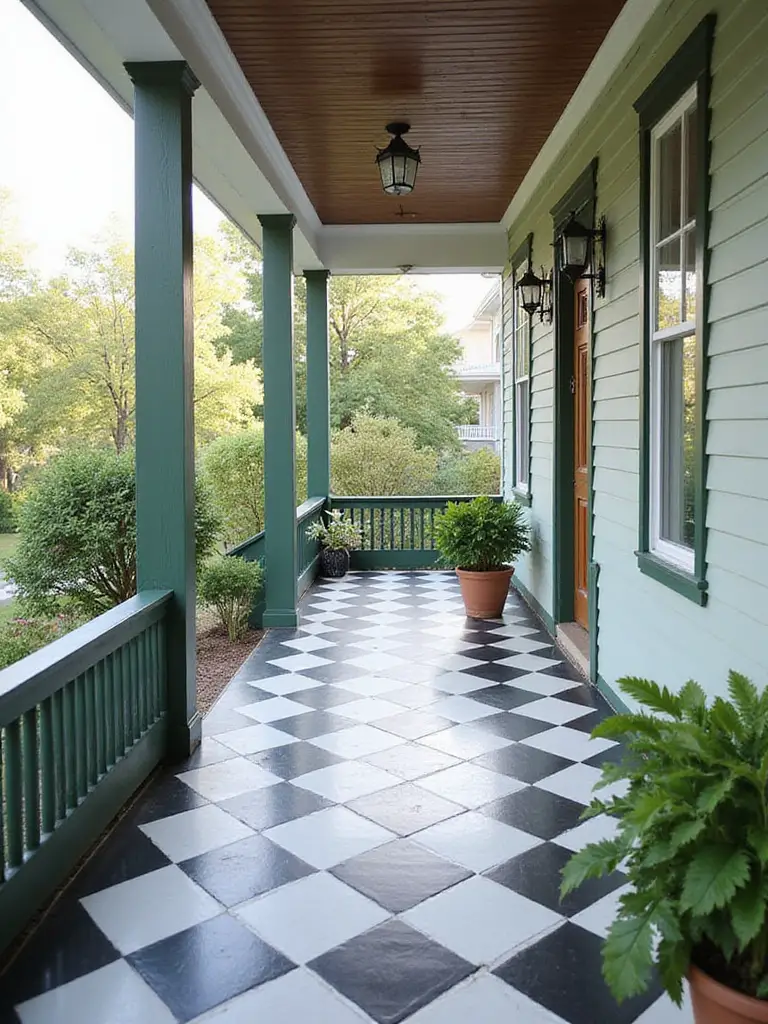
When implementing a checkerboard floor, consider scale carefully—larger squares create a bold, graphic statement while smaller checks offer a more subtle texture from a distance. The classic black and white combination provides maximum contrast and visual impact, but don’t feel limited to this traditional pairing. Navy and cream, charcoal and taupe, or even subtle variations of the same color can create a more nuanced effect while maintaining the ordered structure that makes checkerboard so satisfying to digital minds.
- Large squares (12″+): Bold, graphic statement
- Medium squares (8-10″): Classic proportion
- Small squares (4-6″): Creates texture rather than pattern from a distance
The inherent order of the checkerboard pattern provides a visual organization that helps transition busy minds from the chaos of external stimuli to the order of home—a crucial function in our information-saturated world.
11. Ombre Floor Fade: Digital-to-Analog Transition Visualized
The ombre floor fade physically manifests the transition from digital to analog life—a gradual shift rather than an abrupt change. This gradient effect mirrors how our minds ideally should move between states of focused digital engagement and present-moment awareness, making it particularly meaningful for porch spaces.

Creating a successful ombre requires thoughtful color selection and execution. Consider starting with a deeper, more saturated color at the entrance (representing the intensity of external demands) and gradually transitioning to lighter, more open tones as the floor approaches your home’s entrance (symbolizing the mental lightening as you prepare to enter your sanctuary). This color progression creates not just visual interest but psychological movement through the space.
“The gradient isn’t just decorative—it’s instructive, teaching us through design that transitions should be mindful rather than jarring.”
This contemporary painting technique creates a perfect visual metaphor for the mindful transition between our connected and private lives.
12. Colorful Furniture Pop: Mindful Focal Points in Neutral Space
Against a carefully chosen neutral porch backdrop, colorful furniture creates intentional focal points—visual anchors that draw attention away from screens and back to physical space. This approach allows for expression and energy without overwhelming a space meant for transition and decompression.
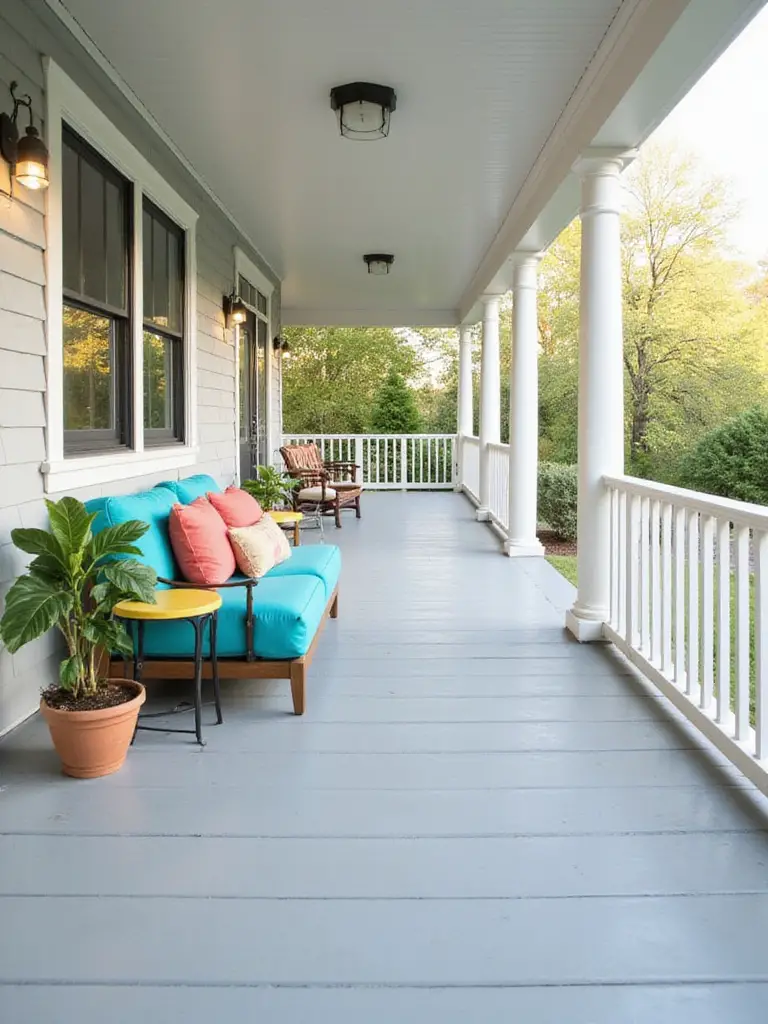
The key lies in selecting furniture colors that energize rather than agitate. Consider tones from the opposite side of the color wheel from your most-used devices—if your digital world is dominated by the cool blues of screens, warm orange or terracotta furniture provides a psychological counterbalance. Limit your palette to two or three coordinating colors to prevent visual chaos, and consider how these colors will appear both in daylight and under evening lighting when the space might serve different functions.
- Select colors that complement rather than match your home’s exterior
- Consider psychological effects—blues calm, reds energize, yellows uplift
- Maintain negative space around colorful elements to prevent visual overload
This balanced approach creates energy and interest while maintaining the porch’s function as a transitional decompression zone between public and private realms.
13. Light and Airy Pastels: Low Visual Weight for Mental Space
Pastel porch paint ideas offer a unique psychological benefit in our high-stimulation digital world—they create visual space that translates to mental space. Their low saturation and high value require less visual processing, creating a gentle landing place for overstimulated minds returning home from information-dense environments.
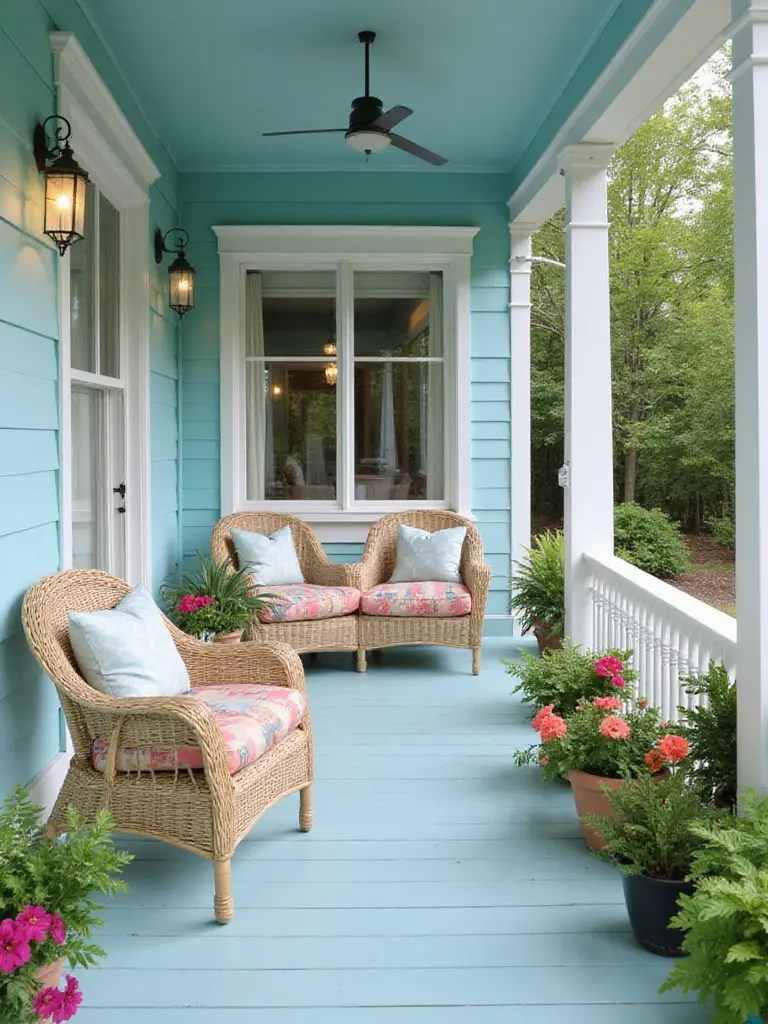
When selecting pastels for your porch, consider both their individual character and how they interact with changing light throughout the day. Soft mint greens bring natural freshness without the intensity of fuller greens. Pale blues expand space and connect to sky elements. Gentle lavenders add sophistication without weight. The key is selecting tones with enough pigment to define the space but enough white to keep them light and reflective.
- Mint: Fresh and natural without intensity
- Pale blue: Expansive and connecting
- Blush: Warm and welcoming without heaviness
These gentle tones create breathing room for the mind—crucial negative space in our visually crowded lives.
14. Dark and Moody Drama: Digital-Free Cocoon Creation
Dark porch paint creates a psychological cocoon—a definitive boundary between the bright, information-heavy outside world and your inner sanctuary. These deep, rich colors signal to the brain that it’s time to shift modes from public to private, from consumption to reflection.
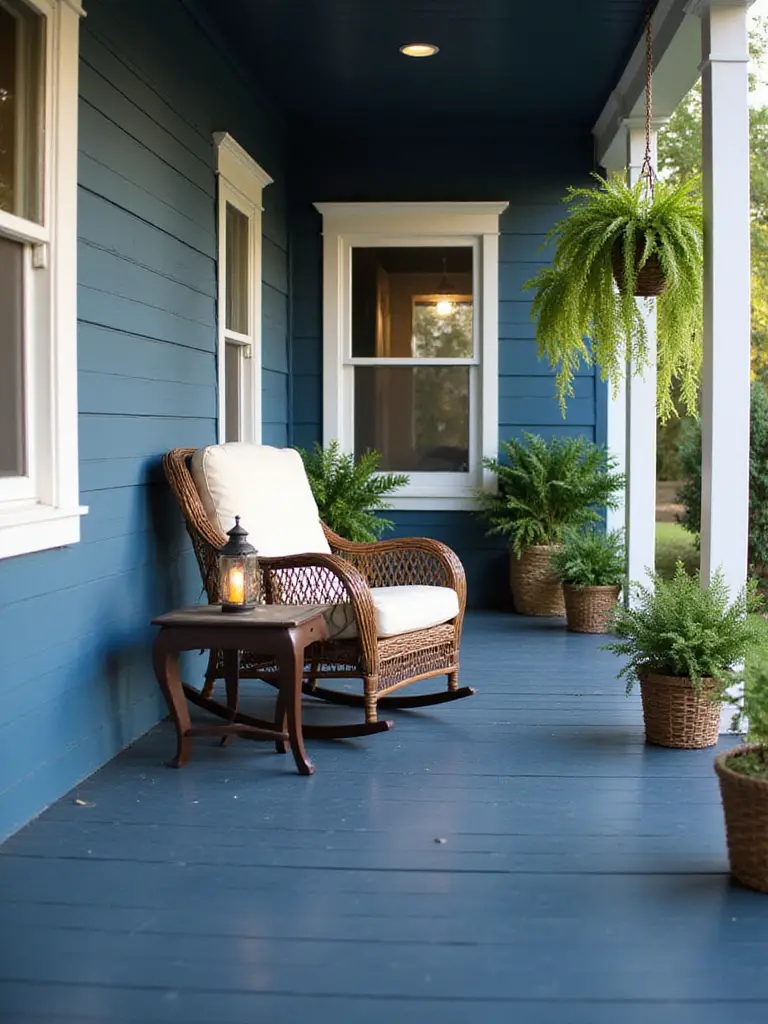
The most effective dark porch colors have depth and complexity rather than flat darkness. Navy blues with subtle undertones shift beautifully between day and evening light. Charcoal grays with slight warmth create sophistication without starkness. Deep forest greens connect to nature while providing dramatic backdrop for both traditional and technological elements. When using dark colors, consider incorporating adequate lighting—both ambient and task—to ensure the space remains functional and welcoming rather than simply dark.
“Dark colors don’t diminish space—they dissolve boundaries, creating infinity rather than confinement.”
This dramatic approach creates a powerful psychological transition between the demanding external world and your mindful internal space.
15. Weathered Wood Texture: Tactile Reality in a Digital World
Faux wood grain painting techniques provide crucial tactile dimension in our increasingly flat, digital world. This porch paint idea reconnects us with material reality through visual texture, creating a sensory bridge between virtual experiences and physical existence—perfect for a transitional space like a porch.
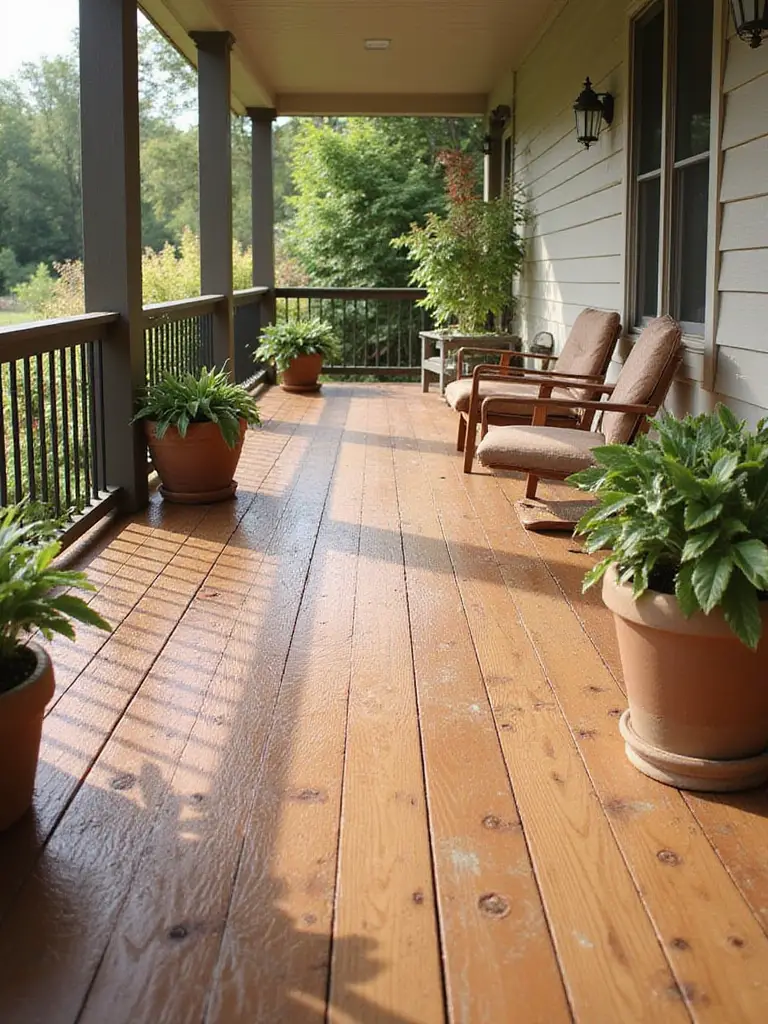
The success of faux wood grain lies in its subtlety and authenticity. Rather than perfect replication, aim for suggestion—the impression of wood’s organic patterns and variations. Consider how natural wood would age in your climate and incorporate these weathering effects into your technique. Slightly irregular patterns and variations in tone create more authentic results than perfect uniformity. The goal is creating a sense of material history and depth that contrasts with the newness and flatness of digital interfaces.
- Use multiple tones rather than a single color
- Incorporate subtle variations in pattern direction
- Include knots and imperfections for authenticity
This technique creates a perfect balance between traditional materials and contemporary convenience—the essence of mindful modern design.
16. High-Gloss Shine & Glamour: Reflective Surfaces for Mindful Awareness
High-gloss porch paint creates reflective surfaces that increase our awareness of light, movement, and presence—a subtle mindfulness tool in physical form. These reflective qualities heighten our consciousness of the environment, encouraging present-moment awareness as we transition between spaces.
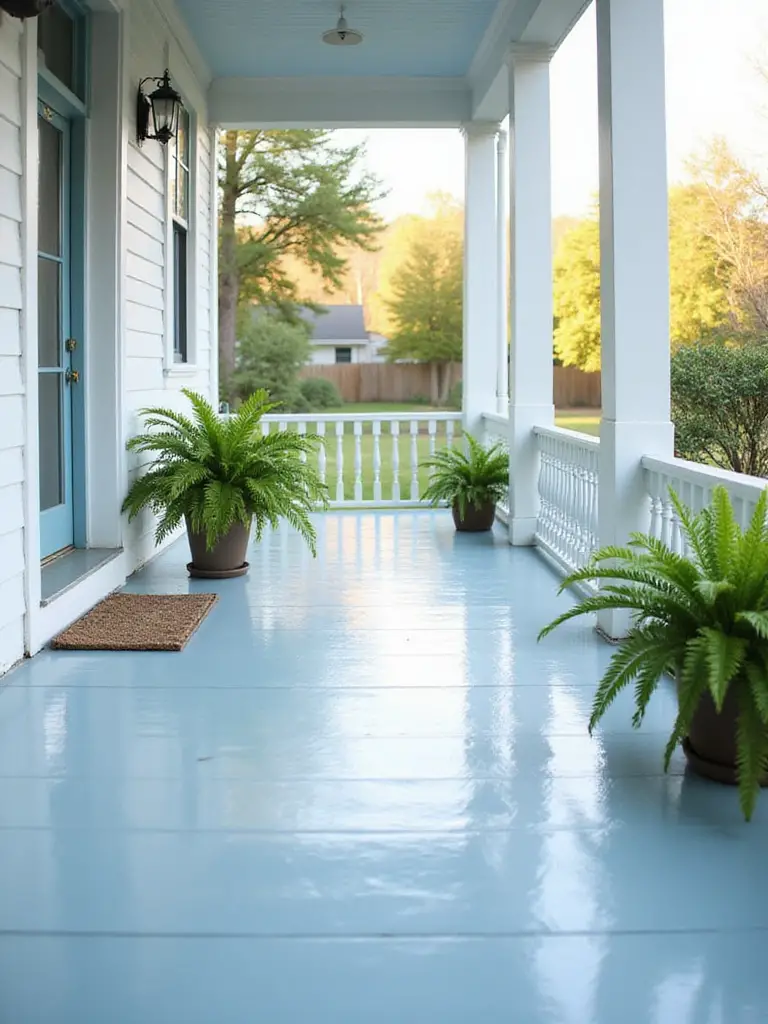
When implementing high-gloss finishes, consider how they interact with both natural and artificial light sources. Morning sunlight creates different reflective patterns than evening porch lighting, and each creates distinct psychological effects. The reflective nature of high-gloss surfaces also visually expands space, creating a sense of openness that counteracts the confinement often felt after hours of screen focus. For maximum impact, consider high-gloss in unexpected applications—not just on floors but perhaps on ceilings or architectural details.
- High-gloss floors create dramatic light play
- Glossy trim highlights architectural details
- Reflective ceilings expand vertical space
This contemporary finish creates a perfect balance of sophistication and sensory engagement—ideal for mindful transition spaces.
17. Matte Finish Comfort: Digital Glare Antidote
In direct contrast to the reflective qualities of high-gloss, matte finishes absorb rather than reflect light—creating a visual rest for eyes fatigued by screen glare. This porch paint idea offers a psychological counterpoint to the high-definition, high-contrast digital world, allowing visual systems to decompress as you transition from public to private space.
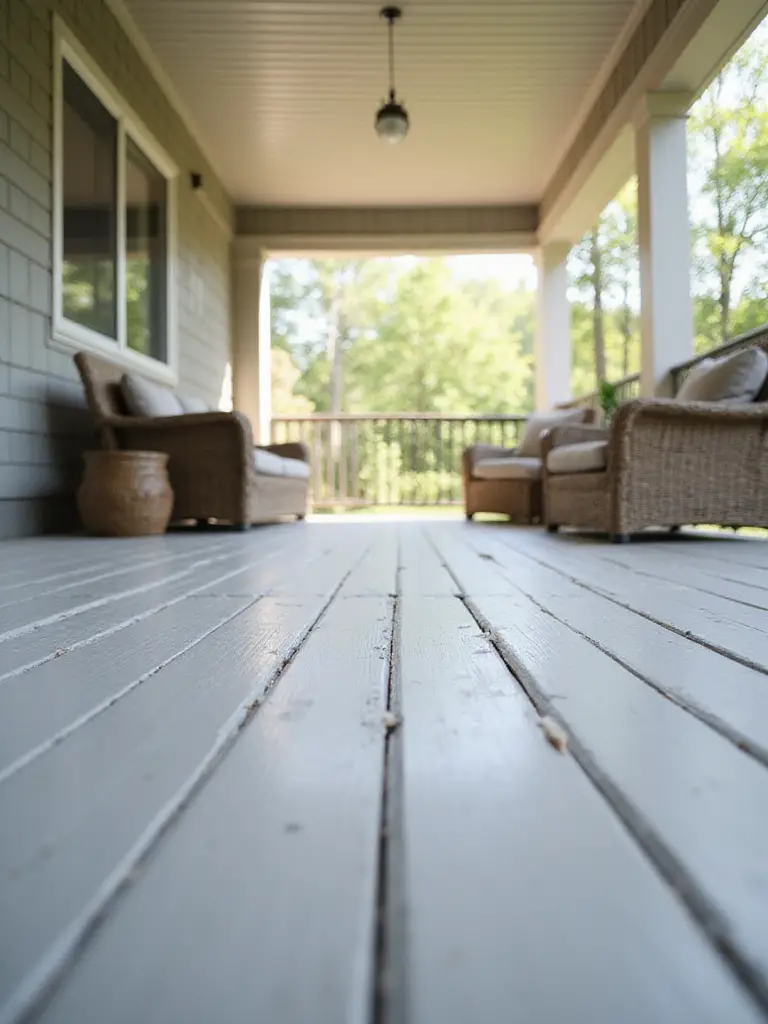
The beauty of matte finishes lies in their subtle depth and dimension. Without reflective distraction, the true color becomes more apparent, creating a purer color experience. Consider slightly warmer tones in matte finishes, as the absence of reflectivity can sometimes make colors appear cooler than intended. The light-absorbing quality creates a cocooning effect that signals to the brain it’s time to shift from external focus to internal awareness—a crucial transition in our hyper-connected lives.
“Matte surfaces don’t just absorb light—they absorb attention, creating space for presence rather than performance.”
This understated finish creates the perfect visual antidote to digital overstimulation, helping eyes and minds rest as you transition to home.
18. Durable High-Traffic Solutions: Practical Foundations for Digital Integration
Durable porch paint provides the practical foundation necessary for seamlessly integrating technology into traditional spaces. These specialized formulations ensure that your porch can withstand not just foot traffic but the installation and use of weather-resistant speakers, lighting systems, and other smart home components that extend your digital ecosystem outdoors.
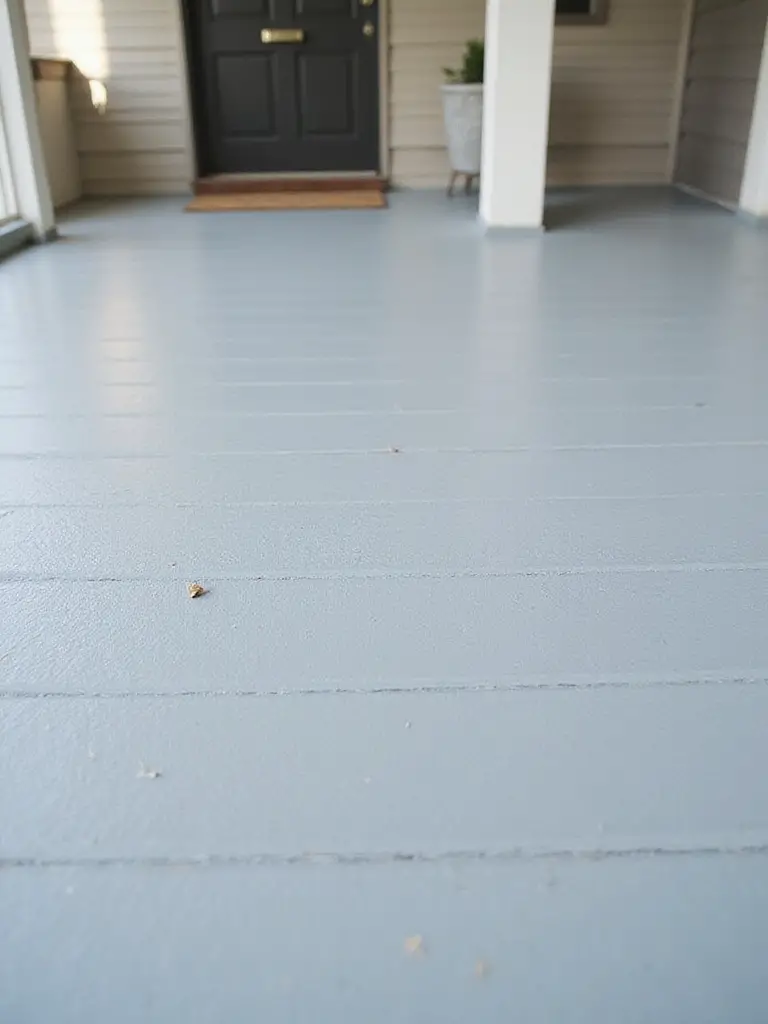
When selecting high-traffic porch paint ideas, consider both composition and application technique. Epoxy-modified acrylics offer exceptional durability without the complexity of true epoxy systems. Polyurethane-fortified paints provide excellent scuff resistance—important for areas where furniture might be moved to accommodate different activities. Always apply multiple thin coats rather than a single thick layer, allowing proper curing time between applications for maximum hardness and longevity.
- Epoxy-modified acrylics: Exceptional durability with easier application
- Polyurethane-fortified: Superior scuff resistance
- Acrylic floor enamels: Good balance of hardness and flexibility
This practical foundation ensures your porch remains both beautiful and functional as it bridges traditional design and modern technology.
19. Cozy Small Porch Colors: Focused Functionality in Limited Space
Small porches demand strategic color choices that maximize both perceived space and functionality. The right porch paint ideas can transform even the most compact area into an effective transition zone between digital demands and mindful home life.
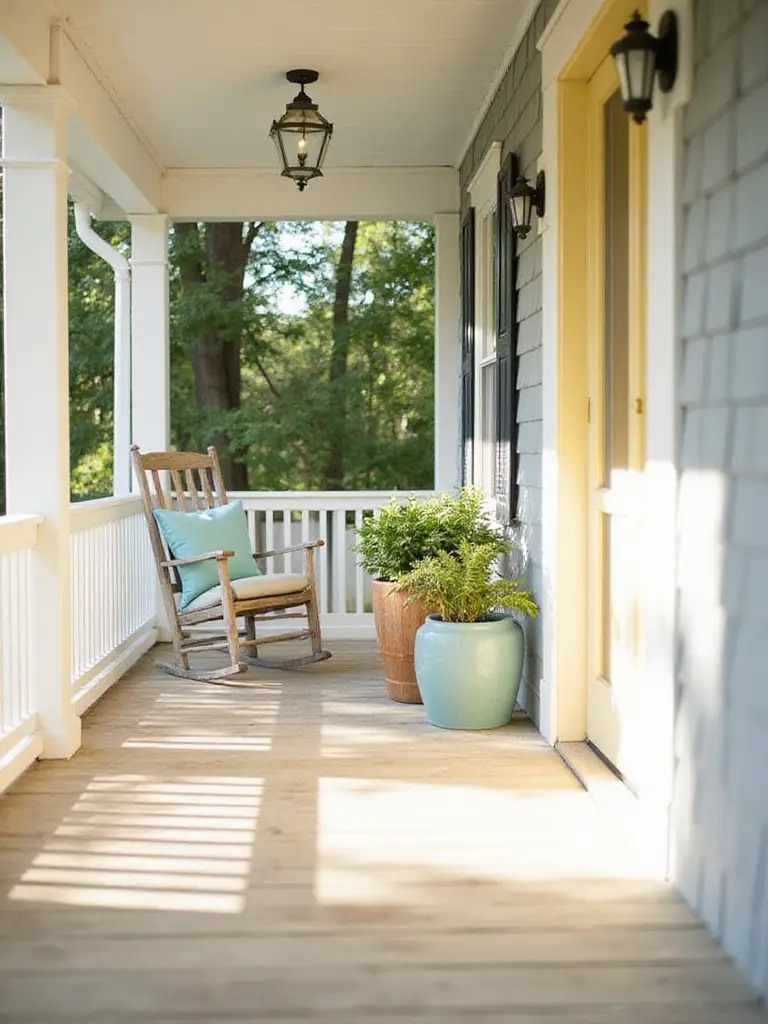
Light colors are traditional choices for small spaces, but the specific undertones matter significantly. Warm whites and creams create intimacy without confinement, while cool whites and pale blues suggest expansion. Consider how your small porch functions in your daily transition routine—if it’s primarily a brief passing-through space, lighter, more energetic colors maintain momentum. If it serves as a mini-decompression zone where you pause before entering, slightly warmer, more grounding tones might better serve this purpose.
- Warm whites: Intimate without confining
- Pale blues: Expansive and calming
- Soft greens: Connecting to nature without overwhelming
These thoughtful color choices ensure even the smallest porch serves its crucial transitional function between the digital and physical aspects of contemporary life.
20. Grand Large Porch Statements: Zoned Living for Digital Balance
Large porches offer the luxury of creating distinct zones for different functions—from tech-friendly work or entertainment areas to screen-free relaxation spaces. Bold porch paint ideas can define these areas without physical barriers, creating intuitive flow between different modes of being.
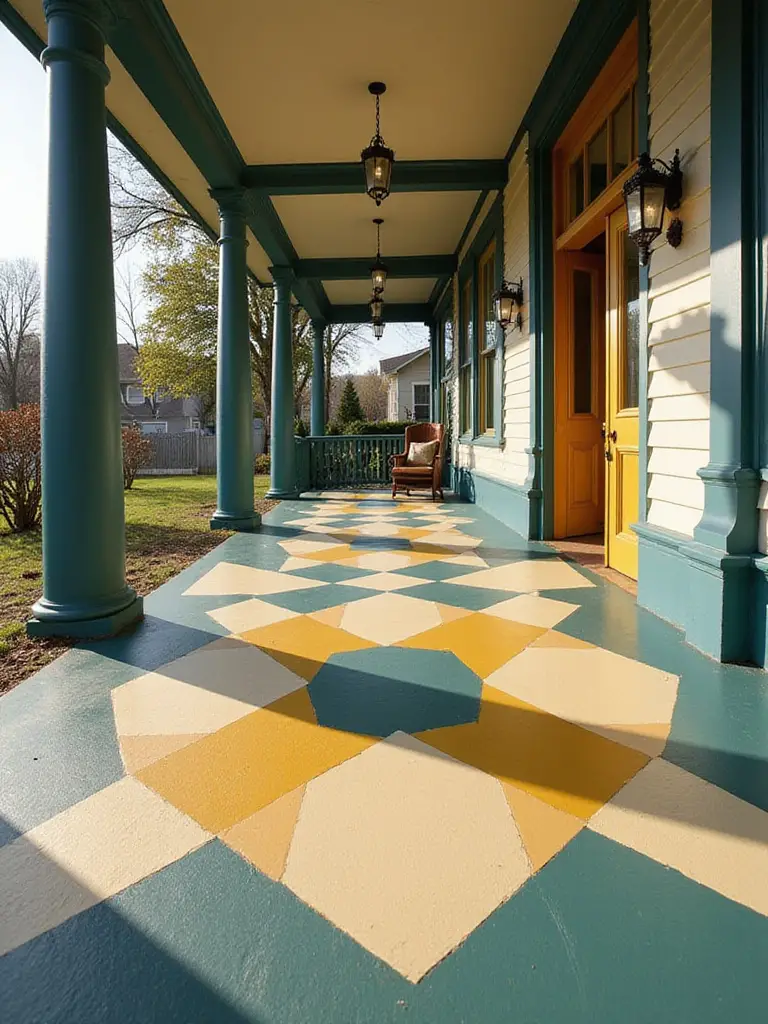
The most effective approach to zoning through paint involves considering both color psychology and practical function. Cooler tones like blues and grays can designate areas intended for focused activities that might involve devices, while warmer tones like terracotta or sage green can signal screen-free relaxation zones. Consider using pattern or color changes to subtly mark these transitions, creating intuitive understanding of each area’s intended function.
“The most effective spaces don’t just accommodate technology—they consciously designate where it belongs and where it doesn’t.”
This intentional approach to large porch design creates the perfect balance between connection and disconnection—a physical manifestation of the digital boundaries we all need to establish.
Finding Your Perfect Porch Paint Balance
The most successful porch paint ideas aren’t just about aesthetics—they’re about creating meaningful transitions between our digital and analog lives. Whether you opt for the serene reset of classic white, the grounding presence of dark moody tones, or the playful energy of stenciled patterns, your porch color should facilitate that crucial shift from external demands to internal peace.
Consider your personal digital habits when selecting from these porch paint ideas. Heavy tech users might benefit from more dramatic transitions like high-contrast colors or bold patterns that visually signal a shift in mode. Those seeking more subtle integration might prefer the gentle guidance of ombre effects or two-tone combinations. Whatever your choice, remember that your porch serves as the threshold between worlds—public and private, connected and contemplative, digital and tangible. Paint it with intention.
